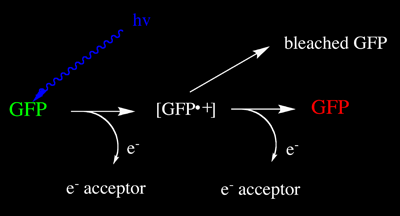Fluorescent Proteins And Photosynthesis In Animals
Fluorescent proteins are found in more than 125 species. What is their function?
Lukyanov and his group have found that fluorescent proteins can act as electron donors when excited. According to their proposal published in Nature Chemical Biology the excited green chromophore (GFP) donates an electron to an electron acceptor forming a short lived intermediate. If no electron acceptor is available the intermediate is permanently bleached, however if it reacts with an electron acceptor the GFP reddens (GFP).
If correct this is remarkable as fluorescent proteins are usually considered to be passive light absorbers and emitters causing bioluminescence, but now Lukyanov is suggesting that “it seems that GFP’s natural function might be as a light activated electron donor – similar to the way that chlorophyll donates electrons in photosynthesis.”
